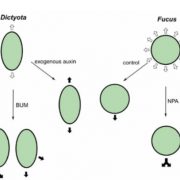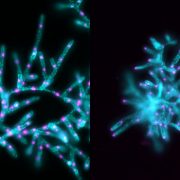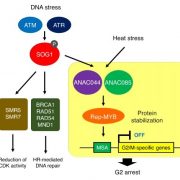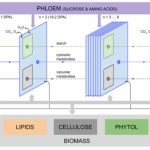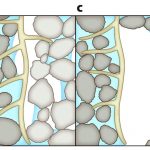Auxin-induced nanoclustering of membrane signaling complexes underlies cell polarity establishment (bioRxiv)
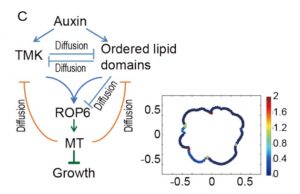 Membranes have long been considered somewhat inert materials in a cell’s organization, but it is becoming clear that lipid composition and distribution contributes actively to cell shape and dynamics. Pan et al. examined the contribution of lipids to the shape of epidermal pavement cells in Arabidopsis leaves. They found that the indentations of the pavement cells showed more ordered lipids (using a dye selective for lipid order) and the accumulation of flotillin proteins, previously shown to associate with sterol-rich membrane nanodomains. Furthermore, pavement cell shape is disrupted in mutants deficient in sterol synthesis. They also found that auxin is required for the promotion of lipid ordering and the formation of cell-surface transmembrane receptor-like kinase 1 (TMK) nanoclusters. Nanoclustering of TMK1 and ROP6 affects cell shape through cortical microtubules, which also feedback and reinforce the membrane nanodomains. This study supports the emerging model that membrane nanodomains are important contributors to auxin responses. (Summary by Mary Williams) bioRxiv 10.1101/734665
Membranes have long been considered somewhat inert materials in a cell’s organization, but it is becoming clear that lipid composition and distribution contributes actively to cell shape and dynamics. Pan et al. examined the contribution of lipids to the shape of epidermal pavement cells in Arabidopsis leaves. They found that the indentations of the pavement cells showed more ordered lipids (using a dye selective for lipid order) and the accumulation of flotillin proteins, previously shown to associate with sterol-rich membrane nanodomains. Furthermore, pavement cell shape is disrupted in mutants deficient in sterol synthesis. They also found that auxin is required for the promotion of lipid ordering and the formation of cell-surface transmembrane receptor-like kinase 1 (TMK) nanoclusters. Nanoclustering of TMK1 and ROP6 affects cell shape through cortical microtubules, which also feedback and reinforce the membrane nanodomains. This study supports the emerging model that membrane nanodomains are important contributors to auxin responses. (Summary by Mary Williams) bioRxiv 10.1101/734665





